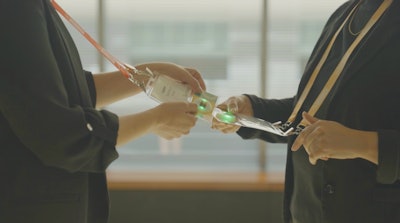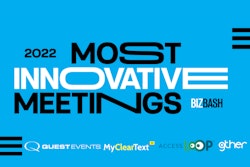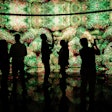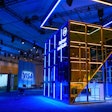
 Alon Alroy, Bizzabo co-founder and CMOPhoto: Courtesy of Bizzabo
Alon Alroy, Bizzabo co-founder and CMOPhoto: Courtesy of Bizzabo
To co-founder and CMO Alon Alroy, it’s all about overcoming what he calls the "event impact gap: the disparity between organizers’ aspirations to create exceptional experiences and their ability to accomplish those aims with their event technology."
To help, Bizzabo recently launched a new wearable on-site technology solution called Klik Experiential and its new SmartBadge, which builds on technology from Klik, a Montreal-based tech start-up that Bizzabo acquired last November. With the simple click of a button, attendees can check into sessions, download content, exchange contact info, and more—and in turn, event organizers can quickly capture priceless behavioral data in real time.
Alroy and his team carefully studied the market while developing the new product—particularly the fact that between January and September 2022, the number of in-person events hosted on Bizzabo’s Event Experience OS increased by a whopping 724%. (Also of note, though, is that the number of virtual events held on the platform has remained consistent, decreasing just 0.43%—showing that there’s still a vital place for virtual options in this evolving world.)
Alroy adds that a recent Bizzabo study found that 85% of event organizers plan to host at least three in-person events in 2023. “As in-person events return, event organizers need a solution to collect behavioral data from in-person events while providing a seamless attendee experience,” he explains.
We chatted with Alroy about the biggest tech trends to expect in 2023—and how the new wearable tech is ready for them.
1. Attendees want convenience—and plenty of engagement and networking opportunities.
As in-person events regain momentum, attendee expectations are higher than ever, notes Alroy, who emphasizes that the SmartBadge “isn’t just a passive accessory—it’s an intuitive asset enabling event experience leaders to transform the in-person experience.”
Many of the product’s features were built specifically with engagement in mind, like the "Audience Lights" feature. “The solution remotely lights up all attendees’ SmartBadges at once, or colors can light up based on defined groups such as ticket types,” says Alroy, noting that it can either be a fun, festival-like engagement option or an easy way to break attendees into groups.
There are also options to gamify the badges through various touchpoints, and attendees can exchange contact information with exhibitors and their peers with the click of a button. For sustainability-minded planners, the product also eliminates unnecessary paper items and shipping and is reusable and recyclable.
2. Data collection is essential to creating satisfied attendees.
“As excited as event professionals are to once again gather in person, they’ve faced the prospect of losing access to vast amounts of data gleaned from virtual event experiences,” Alroy points out. “In-person events have always held enormous data potential, but they’ve long been a black box: full of insights but impenetrable. Our wearable technology gives organizers access to that rich data source.”
Alroy adds that the tech—which ensures data privacy by not storing personal information—will allow planners to get real-time insights into attendees’ interests and preferences, highlighting an event’s most successful components along with the aspects in need of improvement. “With insights like these, event organizers can utilize the wearable data within Bizzabo’s end-to-end software to make real-time adjustments to events, notify attendees of programming updates, provide insight to sales teams with potential leads based on attendee interaction, share sponsor information, and plan for future events,” he says.
The product also unlocks behavioral data tracking via digital heat maps, which lets event organizers visualize attendee engagement on event dashboards. Exhibitors, meanwhile, can use the SmartBadge to simplify the lead-scanning process—meaning there's more time to focus on having engaging conversations.
“In the coming year, the most important measure of return on event (ROE) will be contribution to pipeline, which makes simplified lead retrieval and integration with your customer relationship management platform vital,” Alroy says. “Klik Experiential allows organizers to identify highly engaged attendees, share those contacts with sales teams, and offer customized post-event outreach to speed up sales cycles, enhancing organizers’ ability to drive business outcomes.”
3. The power of technology extends far beyond virtual events.
Ultimately, Alroy believes that Bizzabo’s SmartBadges and other tech are essential for creating what he calls "future-proofed" gatherings. "The pandemic pivot to virtual events required event professionals to open up to the opportunities technology can provide," he says. "This included reaching a greater variety of audiences, garnering valuable data in real-time, increasing sustainability and diversity efforts, and allowing a space for trial and error in finding new ways to engage audiences."
Alroy thinks the key is translating the convenience and exceptions of virtual events into in-person settings—whether that’s by providing hybrid options or leaning on options like wearables to collect real-time data. “In the new year, we expect to see marketers expanding their creativity to engage and connect with attendees using technology to deliver the convenience of virtual events,” he predicts. “This will include exploring more robust technology platforms to support those needs.”



















